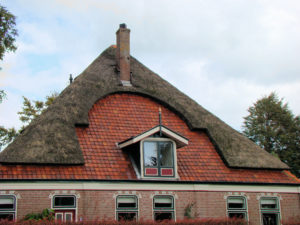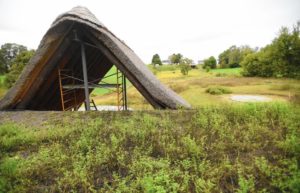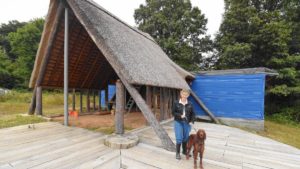Barn New and green
I once attended “Barn Again,” an event at the National Building Museum in Washington, DC, where participants got to help reconstruct a historic barn within the cavernous great hall. It was a blast. Pegs for mortise and tenon joints ‘n all.

This post features my friend Polly Bart, a green builder of great inquisitiveness and resourcefulness (and a Harley rider of many years).
Polly is a true general contractor, but with a twist. She’s a green general contractor, dba Greenbuilders, Inc. Founded in 2004, her company contracts for new and renovated bathrooms, kitchens, green roofs, small interior spaces and outdoor living spaces and, lately, thatched roofs.
What caught my attention about Polly is a recent article about her work in the Real Estate section of The Baltimore Sun. Couldn’t miss it as there was a great pix of her above the fold showing her standing at the thatched roof portion of her barn, a newer project. (Similar pix used here.)
About this barn new, she was quoted as saying: “This building is a demonstration and a laboratory for me.” Were you to know that Bart holds a PhD, any surprise would dissolve. She’s curious like that–laboratories for learning and all.
Thatching is a very green thing as it can be made from material harvested regionally, if not locally. For roofing, the materials can include straw, water reed, sedge, palm leaves, rushes and heather. The materials are layered so as to shed water away from the roof underlayment, much as shingling would. It can be installed with no underlayment as in Bart’s barn; with rafters built closer together for good support when additionally loaded by snow.

As you’d likely know, thatching for roofs has been in use for a very long time, and still is in countries where materials and know-how are abundant. Here’s a very contrasting, yet ag-related use in the Netherlands. It’s a so-called farm house near Alkmaar where the combination of thatch and tile roofing is reported to be common.
 Bart calls her barn building a “hybrid”. From The Sun: “What stands out when approaching the barn is the thatched roof that dominates the front half of the structure. Made from phragmites, a common reed, thatch is a natural insulator.”
Bart calls her barn building a “hybrid”. From The Sun: “What stands out when approaching the barn is the thatched roof that dominates the front half of the structure. Made from phragmites, a common reed, thatch is a natural insulator.”
 “The thatched roof is 13 inches thick and waterproof (the capillary action in the reeds makes them waterproof).”
“The thatched roof is 13 inches thick and waterproof (the capillary action in the reeds makes them waterproof).”
It’s highly resistant to heat build-up so would reduce air conditioning costs derived from typically hotter ambient summer air made so by dark-colored roofing. In fact, while the temperature of a black roof in the summer heat in the Baltimore-Washington region might reach as much as 150º, Bart would have us know that the temperature off her thatched roof would be the same as the ambient temperature surrounding it. Very cool, very green, right? And, it holds in heat, allowing for lower winter heating costs.
Along the backside of the thatched roof is the rest of the barn which is covered by a “conventional” green roof. Its composition is sedem, soil and some local, crushed shale. Crushed shale is to slow rainwater runoff and help assure better filtration through the sedem and soil.
“Bart acknowledges that her thatch is from Turkey. Considered an invasive species in the [U.S.], phragmites do grow in the Chesapeake Bay area and could be harvested for use.” A professional installer came from Ireland to assist her in the thatching job.
Polly told me she’ll harvest the thatch locally next time, now that she’s been through it once. It’ll be more expensive as Turkish labor costs are a fraction of comparable U.S., and container shipping is rather inexpensive for such lightweight material. But, locally-procured is her typical green MO.
What’s for Bart’s barn flooring? Packed earth. She says it’s easy to keep clean after layering beeswax and linseed oil over it, making it waterproof.
For the walls in the attached structure, she’s used straw bales. They’re are coated with lime, water and sand and, like big, parged blocks, installed along the exteriors, recessed under the roof eves.
If thatching is something you’d like to incorporate into your structure and you live in the Baltimore-Washington area, drop Polly an email or leave a VM. She’s smart, affable, and knowledgeable (as a peek at her website would make plain).